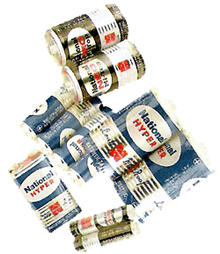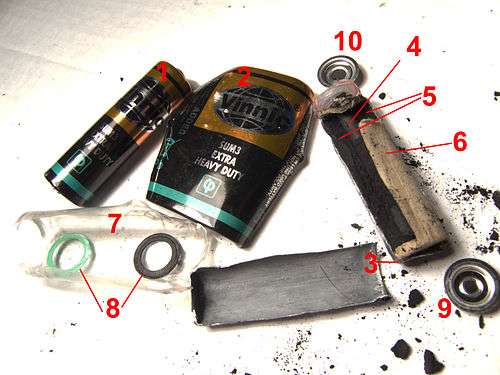Zinc–carbon battery

.
A zinc–carbon battery is a dry cell battery that delivers a potential of 1.5 volts. Although carbon is an important element of the battery's construction, it takes no part in the electrochemical reaction. The cell could more properly be called a "zinc–manganese" cell. The zinc can is the anode and the source of high potential electrons at a higher potential than the other terminal and hence it is marked positive. The manganese dioxide and carbon black paste is the cathode and the inert carbon rod is a non-corrodible conductor that makes the positive pole, which is at lower potential than the anode, hence it is marked with a minus sign. General purpose batteries may use ammonium chloride and/or zinc chloride as the electrolyte.
Zinc–carbon batteries were the first commercial dry batteries, developed from the technology of the wet Leclanché cell (/lɛklɑːnˈʃeɪ/), and made flashlights and other portable devices possible, because the battery can function in any orientation. They are still useful in low drain or intermittent use devices such as remote controls, flashlights, clocks or transistor radios. Zinc–carbon dry cells are single-use primary cells, since they are not intended to be recharged.
History

By 1876, the wet Leclanché cell was made with a compressed block of manganese dioxide. In 1886 Dr. Carl Gassner patented a "dry" version by using a zinc cup as the anode and making the electrolyte with a paste of plaster of Paris (and later, wheat flour) to gel and immobilize the electrolyte. In 1898 Conrad Hubert used consumer batteries manufactured by W. H. Lawrence to power what was the first flashlight, and subsequently the two formed the Ever Ready battery company. In 1900 Gassner demonstrated dry cells for portable lighting at the World's Fair in Paris. Continual improvements were made to the stability and capacity of zinc–carbon cells throughout the 20th Century; by the end of the century the capacity of a zinc–carbon cell had increased fourfold over the 1910 equivalent.[1]
Improvements include the use of purer grades of manganese dioxide, better sealing, and purer zinc for the negative electrode. Zinc chloride cells (usually marketed as "heavy duty" batteries) use a paste primarily composed of zinc chloride, which gives a longer life and steadier voltage output compared with ammonium chloride electrolyte. Manufacturers must now use more highly purified zinc to prevent local action and self-discharge
Zinc-carbon batteries still account for 20% of all portable batteries in the UK, and 18% in the EU.[2][3][4][5] In Japan they account for only 6% of all primary battery sales, and only 7% of all types of batteries sold in Switzerland.
Construction
The container of the zinc–carbon dry cell is a zinc can. The can contains a layer of NH4Cl or ZnCl2 aqueous paste impregnating a paper layer that separates the zinc can from a mixture of powdered carbon (usually graphite powder) & manganese (IV) oxide (MnO2) which is packed around a carbon rod. Carbon is the only practical conductor material because every common metal will quickly corrode away in the positive electrode in salt based electrolyte.
.png)
Early types, and low-cost cells, use a separator consisting of a layer of starch or flour. A layer of starch-coated paper is used in modern cells, which is thinner and allows more manganese dioxide to be used. Originally cells were sealed with a layer of asphalt to prevent drying out of the electrolyte; more recently a thermoplastic washer sealant is used. The carbon rod is slightly porous, which allows accumulated gas to escape while retaining the water for the electrolyte. The ratio of manganese dioxide and carbon powder in the cathode paste affects the characteristics of the cell; more carbon powder lowers the internal resistance, but more manganese dioxide improves capacity.[1]
Flat cells are also made for assembly into batteries with higher voltages, up to about 450 volts. A number of flat cells are stacked up, and the whole assembly is coated in wax to prevent evaporation of water from the electrolyte.
Chemical reactions
In a zinc–carbon dry cell, the outer zinc container is the negatively charged terminal. The zinc is oxidised according to the following half reactions:
Anode (marked -)
- Zn(s) → Zn2+(aq) + 2 e− [E° = −0.7626 V]
Cathode (marked +)
- 2MnO2(s) + 2 e− + 2NH4Cl(aq) → Mn2O3(s) + 2NH3(aq) + H2O(l) + 2 Cl− [E° ≈ +0.5 V]
There are other possible side-reactions, but the overall reaction in a zinc–carbon cell can be represented as:
- Zn(s) + 2MnO2(s) + 2NH4Cl(aq) → Mn2O3(s) + Zn(NH3)2Cl2 (aq) + H2O(l)
If zinc chloride is substituted for ammonium chloride as the primary electrolyte, the anode reaction remains he same but the cathode reaction is:
- MnO2(s) + H2O(l) + e− → MnO(OH)(s) + OH−(aq)
and the overall reaction:
- 4Zn(s) + 8MnO2(s) + ZnCl2(aq) + 9 H2O(l) → 8 MnO(OH)(s) + Zn(OH)Cl(aq) +5H2O +4ZnO
The battery has an electromotive force (e.m.f.) of about 1.5 V. The approximate nature of the e.m.f is related to the complexity of the cathode reaction. The anode (zinc) reaction is comparatively simple with a known potential. Side reactions and depletion of the active chemicals increases the internal resistance of the battery, and this causes the e.m.f. to drop.
Zinc chloride cell
The zinc chloride cell is an improvement on the original zinc–carbon cell, using purer chemicals and giving a longer life and steadier voltage output as it is used. These cells are usually marketed as heavy-duty, extra-heavy-duty, or even super-heavy-duty batteries, and offer about twice the service life of general purpose zinc–carbon cells, or up to four times in continuous-use or high-drain applications.[1]
However, the "heavy duty" moniker is misleading in comparison to alkaline batteries,[6] which offer up to eight times the battery life of heavy duty batteries,[7] especially in continuous-use or high-drain applications.[1]
Storage
Manufacturers recommend storage of zinc–carbon batteries at room temperature; storage at higher temperatures reduces the expected service life.[8] While batteries may be frozen without damage, manufacturers recommend that they be returned to normal room temperature before use, and that condensation on the battery jacket must be avoided. By the end of the 20th century, the storage life of zinc–carbon cells had improved fourfold over expected life in 1910.[1]
Leakage
Zinc carbon batteries may leak. These cells have a short shelf life as the zinc is attacked by ammonium chloride. The zinc container becomes thinner as the cell is used, because zinc metal is oxidized to zinc ions. When the zinc case thins enough, zinc chloride begins to leak out of the battery. The old dry cell is not leak proof and becomes very sticky as the paste leaks through the holes in the zinc case. The zinc casing in the dry cell gets thinner even when the cell is not being used, because the ammonium chloride inside the battery reacts with the zinc. An "inside-out" form with a carbon cup and zinc vanes on the interior, while more leak resistant, has not been made since the 1960s.[1]
This picture shows the zinc container of fresh batteries at (a), and discharged batteries at (b) and (c). The battery shown at (c) had a polyethylene protection film (mostly removed in the photo) to keep the zinc oxide inside the casing.

Environmental impact
Thousands of tons of zinc–carbon batteries are discarded every year around the world and are often not recycled.
Disposal varies by jurisdiction. For example, in the U.S, the state of California considers all batteries as hazardous waste when discarded, and has banned the disposal of batteries with other domestic waste.[9] In Europe, battery disposal is controlled by the WEEE Directive and Battery Directive regulations, and as such zinc-carbon batteries must not be thrown in with domestic waste. In the EU, most stores that sell batteries are required by law to accept old batteries for recycling.

See also
References
- 1 2 3 4 5 6 David Linden, Thomas B. Reddy (ed). Handbook Of Batteries 3rd Edition. McGraw-Hill, New York, 2002 ISBN 0-07-135978-8 Chapter 8
- ↑ Monthly battery sales statistics – MoETI – March 2011
- ↑ INOBAT 2008 statistics.
- ↑ Battery Waste Management – 2006 DEFRA
- ↑ EPBA Sustainability Report 2010
- ↑ "Put a charge into your battery savings". Chicago Tribune. 2015-04-29. Retrieved 2015-06-19.
- ↑ "Zinc Chloride Batteries". Radio Shack. Archived from the original on 2015-02-12. Retrieved 2015-06-19.
- ↑ Eveready: Carbon Zinc Application Notes page 13
- ↑ "Batteries". Waste Prevention Information Exchange. California Department of Resources Recycling and Recovery (CalRecycle). Retrieved 5 September 2012.
External links
| Wikimedia Commons has media related to Zinc-carbon batteries. |
- Eveready: Carbon Zinc Application Notes
- Rayovac: Alkaline and Heavy Duty Application Notes
- Power Stream Battery Chemistry FAQs
- Cell Construction
| ||||||||||||||||||||
